What is your data telling you?
These days athletes are the most excellent data collectors. It is so easy to connect movement to numbers with the available devices. These numbers may get looked at, analyzed, compared to and logged. In swim data, what can these numbers tell us? We have many to look at – distance, pace, stroke rate, stroke count and swolf – and they are easily collected. What can we learn from them?
Finding immediate room for improvement, highlighted via data, was the situation recently in the Discovery Aquatics studio. The athlete came into the session frustrated by her stroke count slowly climbing over the last couple of weeks. She was tracking the data, and despite her best efforts could not manage the counts. It took less than 30 minutes to look at her swimming, find the areas where she could gain efficiency, drop the stroke count, and as a consequence pick up speed.
This process forms a wonderful feedback loop that we can view like this:
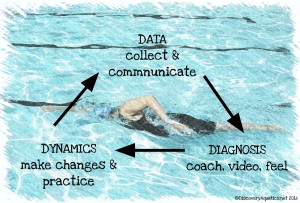
Find and Fix Feedback Loop
And to see the reality of this loop we begin at the top by looking at the data file:
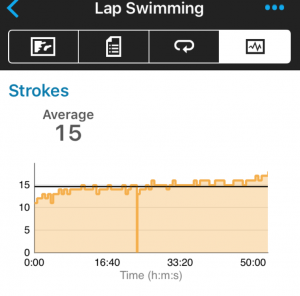
Stroke Count Data File
From the data file of this workout, the athlete could see the stroke count gradually climbing. This was the trend from the last couple of weeks training. It was frustrating when she could not identify the problem and improve the stroke count. She did the right thing and reached out for some time in the studio to help diagnose the issues. A coach can quickly pinpoint the areas for improvement to maximize efficiency and gain speed. Here is an image from the first video analysis. We can see how the body line angles are contributing to resistance and drag, and increasing stroke count.
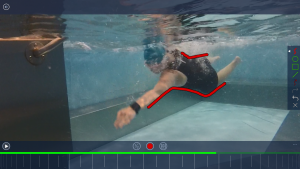
Non Hydrodynamic Body Line
It is my goal as the coach to identify the main technique areas to address in order to improve the body position. Then how do I enable the athlete to see what is needed, implement and feel the change. We found 4 areas that needed fine tuning – using the core to drive the portion of the stroke from recovery entry to lead arm extension, dropping the head to align with the spine and be held in harmony with gravity and the water density, creating a consistent angle of rotation through the whole torso by engaging lower core muscles, and creating an early catch with the palm facing backwards. After some time working on the areas needed for improvement we reviewed video again. This step is important to allow the athlete to get visual confirmation from the change of movement and different feel in the stroke. This really helps ingrain the sensation and will make retrieval in her next pool session easier. Here is an image from the more efficient stroke, and we can see how the body line angles are far more hydrodynamic and will result in a reduction of stroke count.
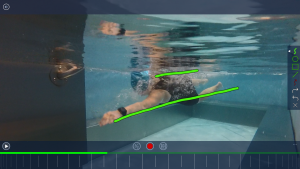
Improved Hydrodynamic Body Line
As this athlete is in half ironman training, we took the improved stroke immediately into the lake to challenge the new movement patterns in the open water environment. The continuity of open water swimming allowed her to settle in and cycle through the changes, and visualize finding efficiency in a more race like setting.
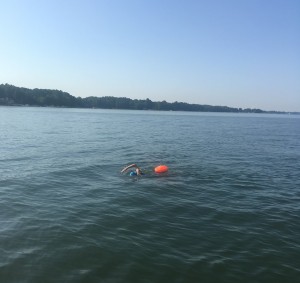
New Movement Patterns in Open Water Environment
Now the athlete has the information to move forward with targeted practices using specific focal points. As she is doing this, the collection of more data is useful to confirm the connection between stroke efficiency and speed. This just in is a sample from her second swim after her session here at the studio.
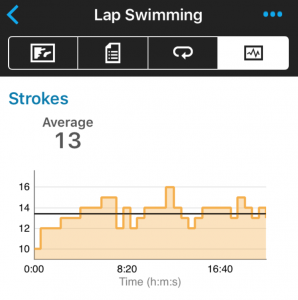
Stroke Count Data File
The feedback loop continues. Stroke count has decreased in the short term, can she keep using the feedback loop to make further improvements to stroke count and speed. Take the data to the next level, insert it into the feedback loop, look for areas to improve, make changes and practice, use data for confirmation. Be in control of your progress.
Coach Dinah

